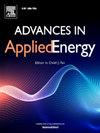Enhancing flexibility in wind-powered hydrogen production systems through coordinated electrolyzer operation
IF 13.8
Q1 ENERGY & FUELS
引用次数: 0
Abstract
Wind-powered water electrolysis for hydrogen production is a sustainable and environmentally friendly energy technology. However, the inherent intermittency and variability of wind power, significantly damage the stability and efficiency of the hydrogen production system. To enhance the operational flexibility and system efficiency, a novel wind-hydrogen production system is proposed, which integrates a new coordination of the conventional alkaline electrolyzers (AEL) and proton exchange membrane electrolyzers (PEMEL), for optimizing the dynamic operation of the system under fluctuating wind power. The developed approach employs variational mode decomposition to classify wind power fluctuations into different frequency components, which are then allocated to suitable type of electrolyzers. The configurations of the developed system are optimized using the non-dominated sorting genetic algorithm, and the operating scenarios are dynamically analyzed through clustering techniques. Compared to the AEL-only system, the proposed system demonstrates significant enhancements, with energy efficiency and internal rate of return increased by 5.78 % and 10.65 %, respectively. Meanwhile, the coordinated operation extends the continuous operating time of the AEL by 7.08 %. The proposed approach enhances the economic viability and operational stability of wind-powered hydrogen production, providing a valuable reference for industrial green hydrogen applications.
通过协调电解槽操作,提高风力制氢系统的灵活性
风力水电解制氢是一种可持续、环保的能源技术。然而,风力发电固有的间歇性和可变性,严重损害了制氢系统的稳定性和效率。为了提高系统运行的灵活性和效率,提出了一种新型的风力制氢系统,该系统将传统的碱性电解槽(AEL)和质子交换膜电解槽(PEMEL)集成在一起,以优化系统在波动风力下的动态运行。所开发的方法采用变分模态分解将风电波动划分为不同的频率分量,然后将其分配给合适类型的电解槽。采用非支配排序遗传算法对所开发的系统进行配置优化,并通过聚类技术对运行场景进行动态分析。与纯ael系统相比,该系统的能源效率和内部收益率分别提高了5.78%和10.65%。同时,协同运行使AEL的连续运行时间延长了7.08%。该方法提高了风力制氢的经济可行性和运行稳定性,为工业绿色氢应用提供了有价值的参考。
本文章由计算机程序翻译,如有差异,请以英文原文为准。
求助全文
约1分钟内获得全文
求助全文

 求助内容:
求助内容: 应助结果提醒方式:
应助结果提醒方式:


